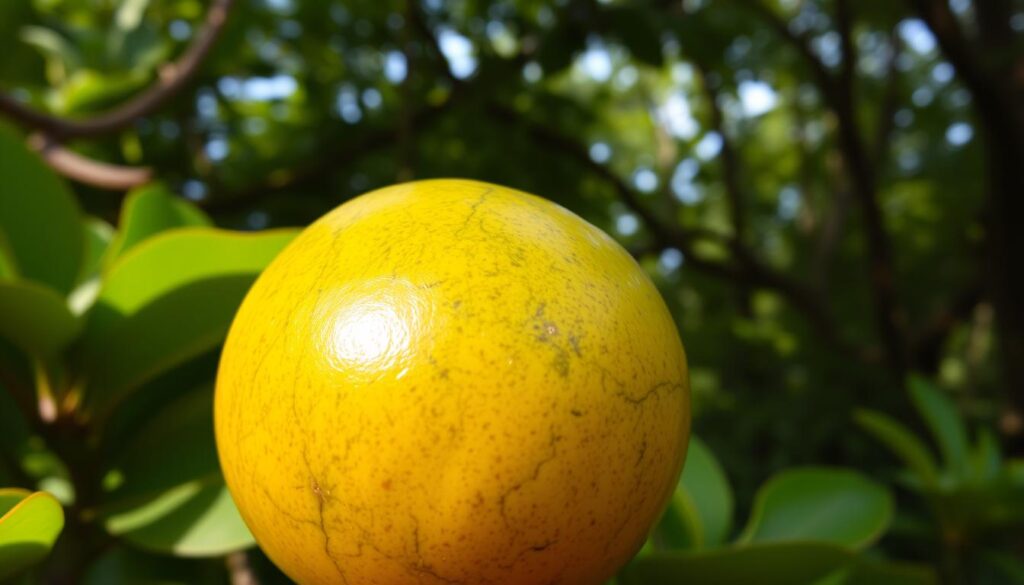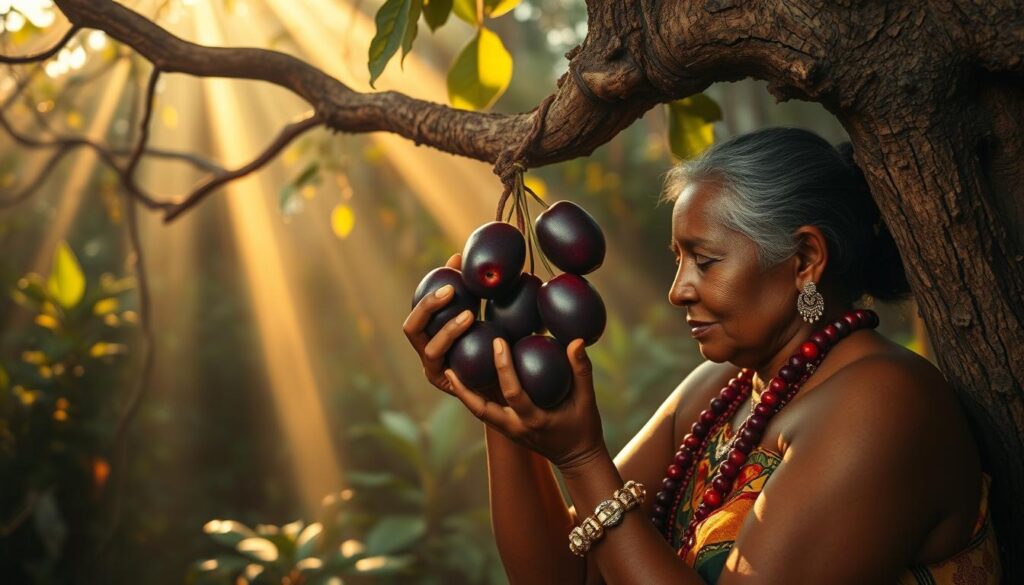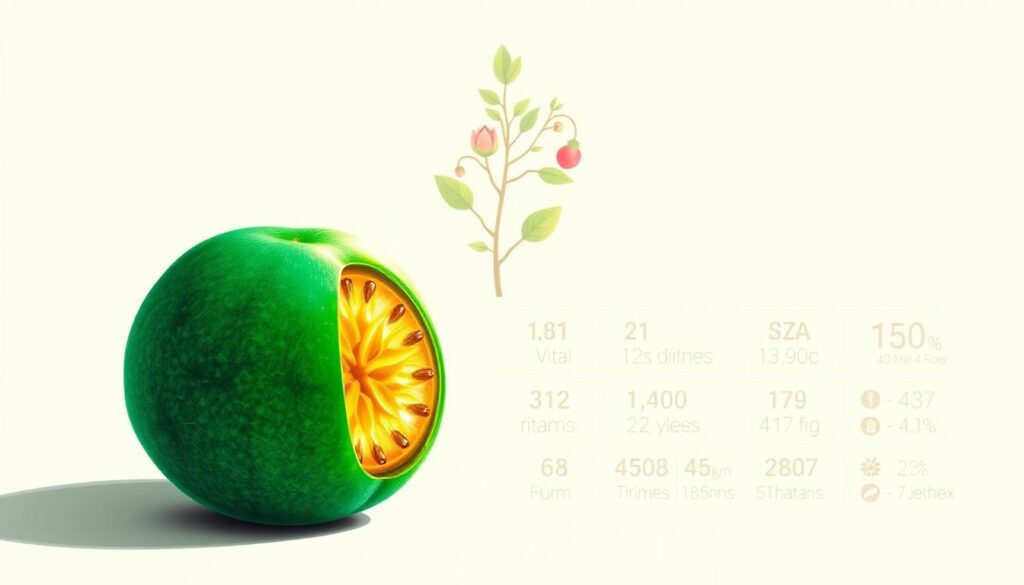In Australia's Outback, the Kakadu plum grows. It's a small fruit with huge nutritional benefits. This Australian superfruit has the most vitamin C of any fruit, even more than oranges.
It's not just high in vitamin C. It also has special phytochemicals and nutrients. These make it a top choice for those looking for superfood benefits.
Key Takeaways
- Kakadu plum holds the title for the world’s highest natural vitamin C source.
- It’s a traditional Indigenous Australian food with modern wellness applications.
- Packed with antioxidants that support immunity and cellular health.
- Used in dietary supplements, skincare, and culinary dishes today.
- Sustainably sourced to preserve native ecosystems and cultural heritage.
What Is the Kakadu Plum?
The Kakadu plum, known as Terminalia ferdinandiana, is a fruit from Australia. It's famous for its high vitamin content. People also call it billy goat plum or gubinge. It grows in the dry woodlands and monsoon forests of northern Australia.

The fruit is small and round, about 2–3 centimeters in size. When it's ripe, it turns from pale green to bright yellow. Its skin is smooth and thin, covering soft flesh. The taste is sour and acidic, but it's packed with nutrients.
Wild trees can grow up to 20 meters tall. They have silver-gray bark and leaves shaped like lances. These features help them survive in dry climates.
- Botanical name: Terminalia ferdinandiana
- Origin: Indigenous to Australia’s Kimberley and Top End regions
- Edible uses: Dried, juiced, or processed into supplements
- Distinctive trait: Highest recorded vitamin C of any known fruit
Even though it's called a plum, it's not related to stone fruits. For centuries, Indigenous people used it as bush tucker. It helped them survive in tough environments. Today, it connects ancient traditions with modern nutrition, showing how nature adapts.
The Origin and History of Kakadu Plum

The Kakadu plum has deep roots in Indigenous knowledge. It is a sacred part of Australia's culture and nature.
Indigenous Australian Heritage
The Kakadu plum comes from Kakadu National Park and northern Australia. It was a key part of Aboriginal bush food for many years. The Bininj/Mungguy people gathered it seasonally.
Its stories in Dreamtime and land care show its importance. It connects to ancestral lands.
Traditional Uses in Aboriginal Culture
Before science knew its value, the fruit was used for food and traditional medicine. Its pulp helped heal wounds, soothe sore throats, and boost health.
“The plum’s bitter taste hides its power to cleanse and restore,”
elders shared. Its leaves and bark were used in rituals and remedies.
Modern Discovery and Global Recognition
- 1980s: Researchers found it had lots of vitamin C, starting interest.
- 2000s: It started being grown commercially, mixing old knowledge with new farming.
- 2020s: Its popularity grew as its native superfruit history met wellness trends.
Now, working with Indigenous groups ensures it's sourced right. This respects its past and shares its benefits globally.
Nutritional Profile of the Kakadu Plum

Scientific studies show the Kakadu plum is packed with nutrients. It has a special mix of vitamins, minerals, and bioactive compounds. This mix is rare in foods.
Record-Breaking Vitamin C Content
The Kakadu plum has the highest vitamin C content of any fruit. It has up to 5,000 mg per 100g—100x more than oranges. This makes it a strong immune support food, helping with collagen and nutrient absorption.
Antioxidant Properties
The plum is full of natural antioxidants. It has ellagic acid and gallic acid. These fight free radicals and reduce oxidative stress. Its ORAC value is 5,600 μmol TE/100g, beating blueberries and pomegranates.
| Superfood | ORAC Value |
|---|---|
| Kakadu Plum | 5,600 |
| Blueberries | 4,669 |
| Pomegranate | 3,280 |
Other Essential Nutrients
Beyond vitamin C, the plum offers:
- Vitamin E (15% DV per 100g)
- Folate (15% DV)
- Calcium and magnesium for bone health
- 3g fiber and 3g protein per serving
Unique Phytochemicals
Phytochemicals like ellagic acid and quercetin fight inflammation. They support cell health and may lower chronic disease risks. Studies show they could help fight cancer and inflammation.
Health Benefits of Kakadu Plum
The Kakadu plum is packed with nutrients that offer real health benefits. It's a strong immune system booster thanks to its high vitamin C. This vitamin helps white blood cells fight off infections.
It also has anti-inflammatory properties from antioxidants like gallic acid. These can help with chronic inflammation issues.
- Skin health benefits come from ellagic acid. It protects skin cells from UV damage and boosts collagen.
- Anti-aging effects are seen in its compounds. They help reduce wrinkles and signs of aging.
- It may help prevent chronic diseases. This is because it fights free radicals, which could lower heart disease and diabetes risks.
Studies also show it supports gut health and may control blood sugar. While more research is needed, both traditional and modern evidence support its benefits. Adding it to your routine can help with anti-aging effects and immune support naturally.
Incorporating Kakadu Plum Into Your Wellness Routine
Kakadu plum is great for health in many ways. You can use it in supplements or skincare. Here's how to add it to your daily routine.
Dietary Supplements
Begin with Kakadu plum powder or vitamin C supplements made from Kakadu. Choose brands that use raw ingredients and don't overprocess. A 200–500mg dose gives you lots of antioxidants.
Keep these supplements in a cool, dark spot. This helps keep the vitamin C strong.
Culinary Applications
Try superfruit recipes with freeze-dried Kakadu plum. Here are some ideas:
- Put powdered forms in smoothies or yogurt for a tangy flavor.
- Blend it into jams or chutneys for a tasty side dish.
- Top salads or oatmeal with freeze-dried bits.
Its strong taste goes well with honey or dark chocolate.
Skincare Products
Kakadu plum is also good for your skin. It's a key ingredient in serums and moisturizers. Look for products that highlight its vitamin C to brighten your skin.
Choose products with organic Kakadu plum extracts for the best results. Use them morning and night to glow.
When using supplements, food, or skincare, focus on quality. Always read labels and talk to a doctor about any interactions.
Sustainability and Ethical Sourcing of Kakadu Plum
As more people want ethical superfood, it's key to harvest Kakadu plum sustainably. Indigenous groups, who have cared for this fruit for ages, work with Aboriginal enterprise to meet today's needs.
Businesses like Anmatyerre Women’s Centre focus on sustainable harvesting. They use methods that harm the environment less and keep nature's variety. When you buy products with the Indigenous Land Management Seal, you help these efforts.
"Our elders taught us to take only what the land gives. Today, we teach others to do the same," says Marika Dyson, a Bininj leader in Kakadu plum stewardship.
Here's how to choose ethically:
- Look for brands that work with Aboriginal enterprise suppliers.
- Check for sustainable harvesting labels on what you buy.
- Support wild harvested Kakadu plum that's fair traded.
Buying responsibly also helps local communities. Programs like the Northern Territory Indigenous Harvest Network teach people to manage wild harvested Kakadu plum well. This way, we protect culture and nature for the next generations.
Conclusion
The Kakadu Plum is a nutritional powerhouse with amazing superfruit benefits. It has more vitamin C than any other fruit, making it a top natural vitamin C source. For thousands of years, Indigenous Australians have valued this fruit in their indigenous Australian food traditions.
Now, Kakadu plum products like supplements and skincare are connecting old wisdom with new wellness. Buying products made ethically helps the environment and honors cultural traditions. Research is still uncovering its many health benefits.
Discovering Kakadu Plum connects us to nature and history. Making smart choices lets us enjoy its benefits while keeping its heritage alive. It's a bridge between ancient traditions and today's health needs.
FAQ
What is the Kakadu plum and where is it found?
The Kakadu plum, known as Terminalia ferdinandiana, is a small fruit from Australia. It grows in the Northern Territory. The fruit is greenish-yellow and tart, ripe from December to February.
How does the vitamin C content of Kakadu plum compare to other fruits?
Kakadu plum has exceptional vitamin C content. It has up to 100 times more vitamin C than oranges. This makes it a powerful source for immune health and wellness.
What are some traditional uses of Kakadu plum in Aboriginal culture?
Indigenous Australians have used Kakadu plum for thousands of years. It's a food and medicine. They use it for colds, infections, and as an antiseptic for wounds.
What types of products can I find that contain Kakadu plum?
You can find dietary supplements like powders, capsules, and extracts. It's also used in food like smoothies and desserts. Plus, it's in skincare products for its vitamin C.
Are there any ethical concerns regarding the harvesting of Kakadu plum?
Yes, there are ethical concerns about harvesting Kakadu plum. The demand can harm wild populations and Indigenous communities. It's important to source it sustainably and ethically.
What health benefits are associated with consuming Kakadu plum?
Eating Kakadu plum can boost your immune system with its vitamin C. It also has antioxidants for cell health and inflammation. It's good for your skin, gut, and heart.
How can I incorporate Kakadu plum into my daily routine?
Add Kakadu plum to your routine with supplements or in meals. Blend it into smoothies or use it in dressings. Skincare fans can find products with Kakadu plum extract for skin benefits.
